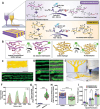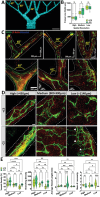Bioprinting of Aptamer-Based Programmable Bioinks to Modulate Multiscale Microvascular Morphogenesis in 4D
- PMID: 39487611
- PMCID: PMC11694088
- DOI: 10.1002/adhm.202402302
Bioprinting of Aptamer-Based Programmable Bioinks to Modulate Multiscale Microvascular Morphogenesis in 4D
Abstract
Dynamic growth factor presentation influences how individual endothelial cells assemble into complex vascular networks. Here, programmable bioinks are developed that facilitate dynamic vascular endothelial growth factor (VEGF) presentation to guide vascular morphogenesis within 3D-bioprinted constructs. Aptamer's high affinity is leveraged for rapid VEGF sequestration in spatially confined regions and utilized aptamer-complementary sequence (CS) hybridization to tune VEGF release kinetics temporally, days after bioprinting. It is shown that spatial resolution of programmable bioink, combined with CS-triggered VEGF release, significantly influences the alignment, organization, and morphogenesis of microvascular networks in bioprinted constructs. The presence of aptamer-tethered VEGF and the generation of instantaneous VEGF gradients upon CS-triggering restricted hierarchical network formation to the printed aptamer regions at all spatial resolutions. Network properties improved as the spatial resolution decreased, with low-resolution designs yielding the highest network properties. Specifically, CS-treated low-resolution designs exhibited significant vascular network remodeling, with an increase in vessel density(1.35-fold), branching density(1.54-fold), and average vessel length(2.19-fold) compared to non-treated samples. The results suggest that CS acts as an external trigger capable of inducing time-controlled changes in network organization and alignment on-demand within spatially localized regions of a bioprinted construct. It is envisioned that these programmable bioinks will open new opportunities for bioengineering functional, hierarchically self-organized vascular networks within engineered tissues.
Keywords: 3D‐bioprinting; aptamers; dynamic growth factors presentation; programmable bioinks; tissue engineering; vascular endothelial growth factor; vascularization.
© 2024 The Author(s). Advanced Healthcare Materials published by Wiley‐VCH GmbH.
Conflict of interest statement
The authors declare no conflict of interest.
Figures








Similar articles
-
Spatial control of self-organizing vascular networks with programmable aptamer-tethered growth factor photopatterning.Mater Today Bio. 2023 Jan 20;19:100551. doi: 10.1016/j.mtbio.2023.100551. eCollection 2023 Apr. Mater Today Bio. 2023. PMID: 36747582 Free PMC article.
-
ECM concentration and cell-mediated traction forces play a role in vascular network assembly in 3D bioprinted tissue.Biotechnol Bioeng. 2020 Apr;117(4):1148-1158. doi: 10.1002/bit.27250. Epub 2020 Jan 11. Biotechnol Bioeng. 2020. PMID: 31840798
-
Bioink with cartilage-derived extracellular matrix microfibers enables spatial control of vascular capillary formation in bioprinted constructs.Biofabrication. 2022 Apr 20;14(3). doi: 10.1088/1758-5090/ac6282. Biofabrication. 2022. PMID: 35354130
-
Multiscale bioprinting of vascularized models.Biomaterials. 2019 Apr;198:204-216. doi: 10.1016/j.biomaterials.2018.08.006. Epub 2018 Aug 3. Biomaterials. 2019. PMID: 30244825 Free PMC article. Review.
-
Construction Form and Application of Three-Dimensional Bioprinting Ink Containing Hydroxyapatite.Tissue Eng Part B Rev. 2024 Oct;30(5):507-521. doi: 10.1089/ten.teb.2023.0280. Epub 2024 Apr 3. Tissue Eng Part B Rev. 2024. PMID: 38569169 Review.
Cited by
-
Genetic and bioactive functionalization of bioinks for 3D bioprinting.Bioprocess Biosyst Eng. 2025 Sep;48(9):1421-1449. doi: 10.1007/s00449-025-03180-y. Epub 2025 May 20. Bioprocess Biosyst Eng. 2025. PMID: 40392297 Review.
References
MeSH terms
Substances
Grants and funding
LinkOut - more resources
Full Text Sources

